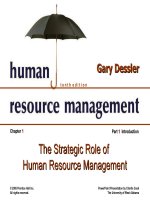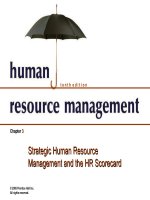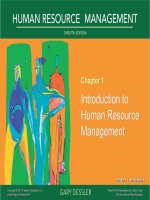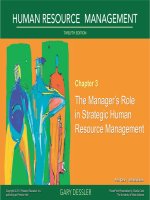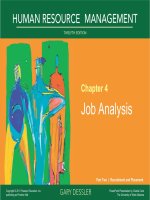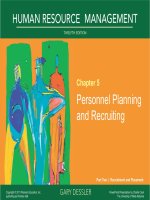Dessler HRM 12e ch 07 interviewing candidates
Bạn đang xem bản rút gọn của tài liệu. Xem và tải ngay bản đầy đủ của tài liệu tại đây (941.96 KB, 26 trang )
Chapter 7
Interviewing
Candidates
Part Two | Recruitment and Placement
Copyright © 2011 Pearson Education, Inc.
publishing as Prentice Hall
PowerPoint Presentation by Charlie Cook
The University of West Alabama
WHERE WE ARE NOW…
Copyright © 2011 Pearson Education, Inc. publishing as Prentice Hall
7–2
LEARNING OUTCOMES
1. List the main types of selection interviews.
2. List and explain main errors that can undermine an
interview’s usefulness.
3. Define a structured situational interview.
4. Explain and illustrate each guideline for being a more
effective interviewer.
5. Give several examples of situational questions,
behavioral questions, and background questions that
provide structure.
6. List the steps in a streamlined interview process.
7. List guidelines for interviewees.
Copyright © 2011 Pearson Education, Inc. publishing as Prentice Hall
7–3
Basic Types of Interviews
Selection Interview
Types of
Interviews
Appraisal Interview
Exit Interview
Copyright © 2011 Pearson Education, Inc. publishing as Prentice Hall
7–4
Selection Interview Structure
Selection Interview
Characteristics
Interview
structure
Interview
content
Copyright © 2011 Pearson Education, Inc. publishing as Prentice Hall
Interview
administration
7–5
Selection Interview Formats
Interview Structure
Formats
Unstructured
(nondirective)
interview
Copyright © 2011 Pearson Education, Inc. publishing as Prentice Hall
Structured
(directive)
interview
7–6
FIGURE 7–1
Officer Programs Applicant Interview Form
Copyright © 2011 Pearson Education, Inc. publishing as Prentice Hall
7–7
EEOC Aspects of Interviews
Use objective/job-related questions
Avoiding
Discrimination
in Interviews
Standardize interview administration
Use multiple interviewers
Copyright © 2011 Pearson Education, Inc. publishing as Prentice Hall
7–8
Interview Content
Types of Questions Asked
Situational
interview
Behavioral
interview
Copyright © 2011 Pearson Education, Inc. publishing as Prentice Hall
Job-related
interview
Stress
interview
7–9
Administering the Interview
Unstructured
sequential interview
Panel
interview
Structured
sequential interview
Ways in
Which
Interview Can
be Conducted
Mass
interview
Computerized
interviews
Copyright © 2011 Pearson Education, Inc. publishing as Prentice Hall
Phone
interviews
Video/Web-assisted
interviews
7–10
Three Ways to Make the Interview
Useful
Structure the interview to
increase its validity
Making the
Interview Useful
Carefully choose what sorts of
traits are to be assessed
Beware of committing
interviewing errors
Copyright © 2011 Pearson Education, Inc. publishing as Prentice Hall
7–11
What Can Undermine An Interview’s
Usefulness?
Nonverbal behavior
and impression
management
First impressions (snap
judgments)
Interviewer’s
misunderstanding
of the job
Factors Affecting
An Interview’s
Usefulness
Candidate-order
(contrast) error and
pressure to hire
Copyright © 2011 Pearson Education, Inc. publishing as Prentice Hall
Applicant’s personal
characteristics
Interviewer’s
inadvertent behavior
7–12
How to Design and Conduct
An Effective Interview
•
The Structured Situational Interview
Use either situational questions or behavioral questions that
yield high criteria-related validities.
Step 1: Analyze the job.
Step 2: Rate the job’s main duties.
Step 3: Create interview questions.
Step 4: Create benchmark answers.
Step 5: Appoint the interview panel and conduct
interviews.
Copyright © 2011 Pearson Education, Inc. publishing as Prentice Hall
7–13
How to Conduct a More Effective
Interview
Being Systematic and Effective
1
Know the job.
2
Structure the interview.
3
Get organized.
4
Establish rapport.
5
Ask questions.
6
7
Take brief, unobtrusive notes.
Close the interview.
8
Review the interview.
Copyright © 2011 Pearson Education, Inc. publishing as Prentice Hall
7–14
Creating Effective Interview
Structures
• Base questions on actual job duties.
• Use job knowledge, situational or behavioral
questions, and objective criteria to evaluate
interviewee’s responses.
• Use the same questions with all candidates.
• Use descriptive rating scales (excellent, fair,
poor) to rate answers.
• If possible, use a standardized interview form.
Copyright © 2011 Pearson Education, Inc. publishing as Prentice Hall
7–15
FIGURE 7–2
Examples of Questions That Provide Structure
Situational Questions
1. Suppose a more experienced coworker was not following standard work procedures and
claimed the new procedure was better. Would you use the new procedure?
2. Suppose you were giving a sales presentation and a difficult technical question arose that
you could not answer. What would you do?
Past Behavior Questions
3. Based on your past work experience, what is the most significant action you have ever
taken to help out a coworker?
4. Can you provide an example of a specific instance where you developed a sales
presentation that was highly effective?
Background Questions
5. What work experiences, training, or other qualifications do you have for working in a
teamwork environment?
6. What experience have you had with direct point-of-purchase sales?
Job Knowledge Questions
7. What steps would you follow to conduct a brainstorming session with a group of employees
on safety?
8. What factors should you consider when developing a television advertising campaign?
Copyright © 2011 Pearson Education, Inc. publishing as Prentice Hall
7–16
FIGURE 7–3
1.
2.
3.
4.
5.
6.
7.
8.
9.
10.
11.
12.
13.
14.
15.
16.
17.
18.
19.
20.
21.
22.
23.
24.
Suggested Supplementary Questions for Interviewing Applicants
How did you choose this line of work?
What did you enjoy most about your last job?
What did you like least about your last job?
What has been your greatest frustration or disappointment on your present job? Why?
What are some of the pluses and minuses of your last job?
What were the circumstances surrounding your leaving your last job?
Did you give notice?
Why should we be hiring you?
What do you expect from this employer?
What are three things you will not do in your next job?
What would your last supervisor say your three weaknesses are?
What are your major strengths?
How can your supervisor best help you obtain your goals?
How did your supervisor rate your job performance?
In what ways would you change your last supervisor?
What are your career goals during the next 1–3 years? 5–10 years?
How will working for this company help you reach those goals?
What did you do the last time you received instructions with which you disagreed?
What are some things about which you and your supervisor disagreed? What did you do?
Which do you prefer, working alone or working with groups?
What motivated you to do better at your last job?
Do you consider your progress in that job representative of your ability? Why?
Do you have any questions about the duties of the job for which you have applied?
Can you perform the essential functions of the job for which you have applied?
Copyright © 2011 Pearson Education, Inc. publishing as Prentice Hall
7–17
Using a Streamlined Interview
Process
1. Prepare for the interview
3. Conduct the interview
•
•
•
•
Knowledge and experience
Motivation
Intellectual capacity
Personality factor
•
•
Have a plan
Follow your plan
4. Match the candidate to the job
2. Formulate questions to ask
in the interview
•
•
•
•
Intellectual factor
Motivation factor
Personality factor
Knowledge and experience
factor
Copyright © 2011 Pearson Education, Inc. publishing as Prentice Hall
7–18
FIGURE 7–4
Interview Evaluation
Form
Copyright © 2011 Pearson Education, Inc. publishing as Prentice Hall
7–19
Guidelines for Interviewees
• Preparation is essential.
• Uncover the interviewer’s real needs.
• Relate yourself to the interviewer’s needs.
• Think before answering.
• Remember that appearance and enthusiasm are important.
• Make a good first impression.
• Ask questions.
Copyright © 2011 Pearson Education, Inc. publishing as Prentice Hall
7–20
FIGURE 7–5
1.
2.
3.
4.
5.
6.
7.
8.
9.
10.
11.
12.
13.
14.
15.
16.
17.
18.
19.
20.
21.
22.
23.
24.
25.
Interview Questions to Ask
What is the first problem that needs the attention of the person you hire?
What other problems need attention now?
What has been done about any of these to date?
How has this job been performed in the past?
Why is it now vacant?
Do you have a written job description for this position?
What are its major responsibilities?
What authority would I have? How would you define its scope?
What are the company’s five-year sales and profit projections?
What needs to be done to reach these projections?
What are the company’s major strengths and weaknesses?
What are its strengths and weaknesses in production?
What are its strengths and weaknesses in its products or its competitive position?
Whom do you identify as your major competitors?
What are their strengths and weaknesses?
How do you view the future for your industry?
Do you have any plans for new products or acquisitions?
Might this company be sold or acquired?
What is the company’s current financial strength?
What can you tell me about the individual to whom I would report?
What can you tell me about other persons in key positions?
What can you tell me about the subordinates I would have?
How would you define your management philosophy?
Are employees afforded an opportunity for continuing education?
What are you looking for in the person who will fill this job?
Copyright © 2011 Pearson Education, Inc. publishing as Prentice Hall
7–21
KEY TERMS
unstructured (or nondirective) interview
structured (or directive) interview
situational interview
behavioral interview
job-related interview
stress interview
unstructured sequential interview
structured sequential interview
panel interview
mass interview
candidate-order error (or contrast) error
structured situational interview
Copyright © 2011 Pearson Education, Inc. publishing as Prentice Hall
7–22
FIGURE 7–A1
Structured Interview
Guide
Copyright © 2011 Pearson Education, Inc. publishing as Prentice Hall
7–23
FIGURE 7–A1
Structured Interview
Guide (cont’d)
Copyright © 2011 Pearson Education, Inc. publishing as Prentice Hall
7–24
FIGURE 7–A1
Structured Interview
Guide (cont’d)
Copyright © 2011 Pearson Education, Inc. publishing as Prentice Hall
7–25


